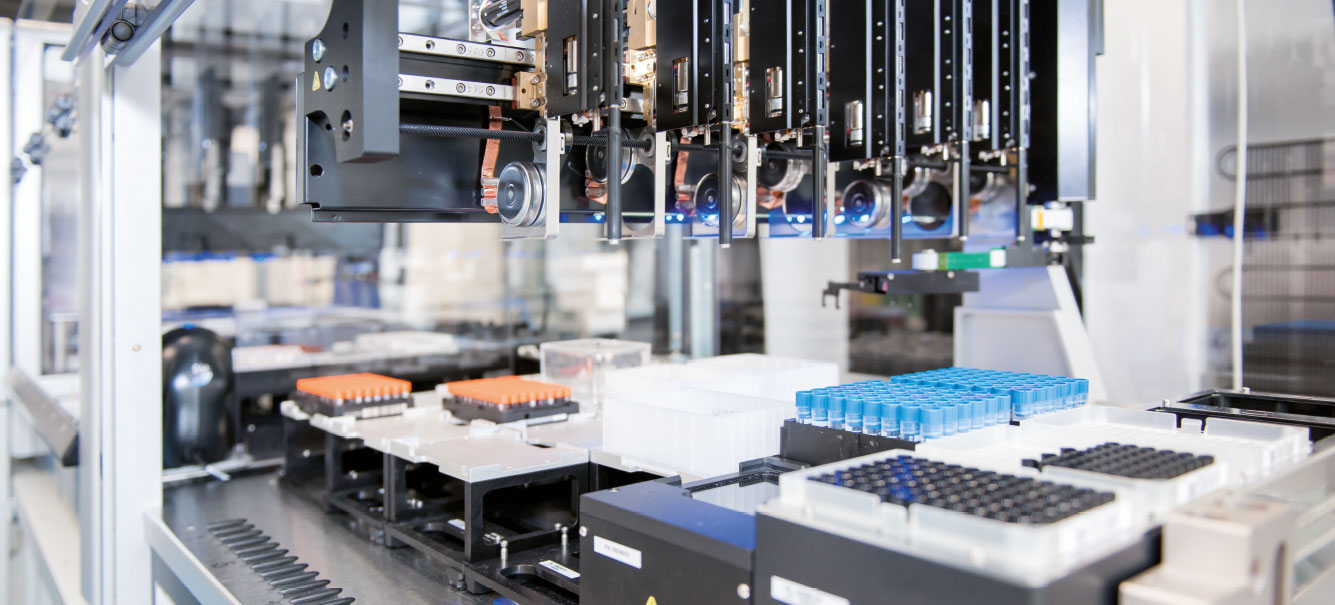
Health Research in 4D - Diagnostics

The pipetting robot’s tips slowly descend over tiny test tubes containing tissue samples, dripping a solution that dissolves the tissue. The pipettes’ tips rise silently as the test tubes shuttle down the line to the next station. A downstream device mixes in reagents, centrifuging and purifying the sample step by step until pure RNA comes to the fore.
RNA is the object of investigation in the RIBULUTION project, which has been underway at Leipzig’s Fraunhofer Institute for Cell Therapy and Immunology IZI since 2011. It is funded by the Fraunhofer Future Foundation. RNA’s structure is similar to that of DNA. While DNA resides in the cell nucleus and carries genetic information, RNA serves various purposes within the cell. Scientists know a great deal about messenger RNAs that hold the code for protein synthesis. Non-coding RNAs, or ncRNAs, for short, are a more recent discovery. They regulate diverse processes in the cells, which makes them prime candidates for research. The idea is that ncRNAs’ profile will indicate if a disease has thrown the regulation of cellular activities out of balance.
Biomarkers for prostate cancer
With this hypothesis in mind, Prof. Friedemann Horn and his team at Fraunhofer IZI began their search for biomarkers to diagnose prostate cancer. The current PSA test is flawed – too many false alarms – so a reliable test is urgently needed. “An elevated PSA level usually prompts a biopsy. Over 200,000 prostate biopsies are performed every year in Germany, but the suspected carcinoma is only confirmed in around 67,000 patients,” says Horn. So, many of these biopsies are unnecessary.
First the RIBULUTION team isolated all the RNA from tumor samples, benign growths and healthy tissue. A single tissue sample may contain several hundred thousand different molecules. The researchers sequenced and compared molecules, and then tallied the ncRNAs to identify the most frequently occurring types in the given samples. Other Fraunhofer Institutes and industrial enterprises helped automate the workflow from end to end with pipetting robots to process large quantities of samples, thereby creating the platform technology for RNA analysis.
Automated platform technology
“We have identified around ten ncRNA molecules that are suitable biomarkers. They provide the basis for a test to diagnose prostate cancer in urine,” says Friedemann Horn. He expects the drug to be launched in 2020, by which time an ncRNA test should also be available. It will help predict if the prostate carcinoma is aggressive and requires immediate surgery or if it grows so slowly that surgery may be unnecessary.
This automated method can help find new biomarkers for a wide range of diseases relatively quickly. The platform technology is sure to interest pharmaceutical companies that are developing tests to monitor the efficacy of new drugs in clinical trials.
Research in diagnostics and therapy is converging. Nowhere do the two mesh as tightly as in theranostic implants that combine therapy and diagnosis in a single system. The Fraunhofer Institute for Biomedical Engineering IBMT at St. Ingbert is developing this type of implant
Further information
RIBOLUTION Biomarker Center
At the RIBOLUTION Biomarker Center, novel biomarkers are identified based on ribonucleic acids and developed through to clinical “proof of concept” with the aid of selected patient cohorts. At present, activities are primarily focused on development programs in the areas of prostate cancer, chronic obstructive pulmonary disease (COPD) and infectious diseases.
Fraunhofer Lighthouse Project: "Theranostic Implants"
Twelve Fraunhofer Institutes led by the Fraunhofer Institute for Biomedical Engineering IBMT have joined forces to work on the Fraunhofer lead project “Theranostic Implants”. Until now most implants have been of the purely passive type – a typical example is orthopedic devices for bone repair. But there is a growing interest in active “theranostic” implants that combine therapeutic and diagnostic functions in a single medical device. These devices create a closed feedback loop in which vital parameters are recorded and provide the input for therapeutic intervention.